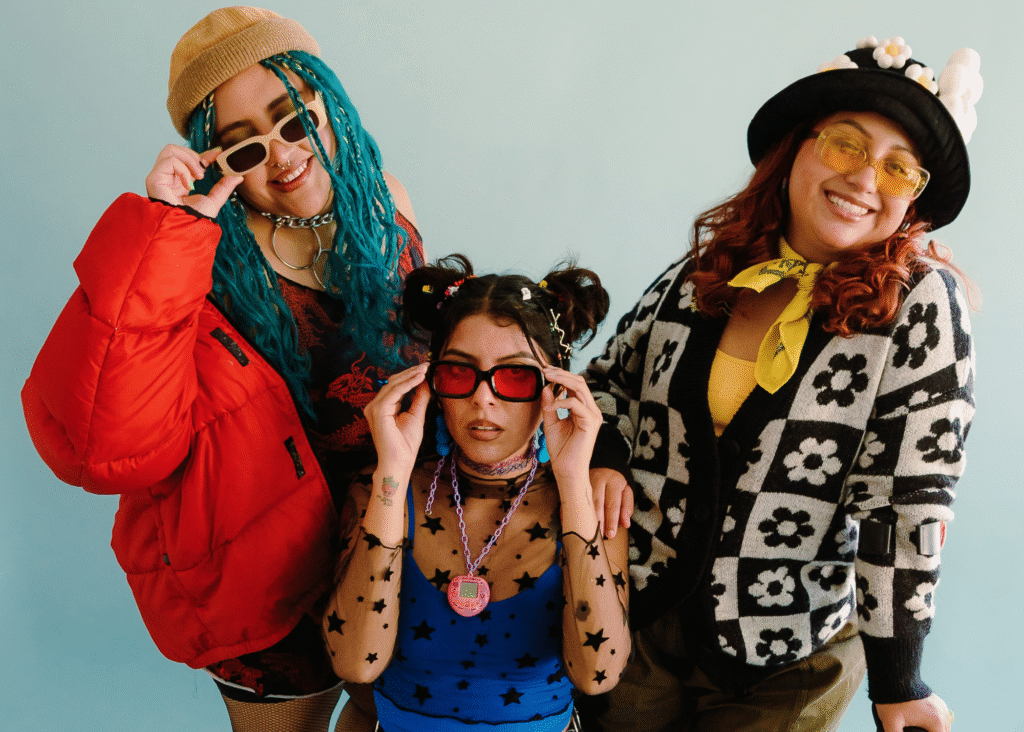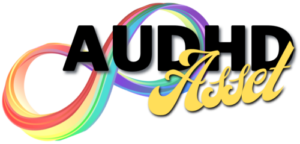What is AUDHD?
AuDHD is a blend of the terms Autism and ADHD, used by people who are both autistic and have Attention-Deficit/Hyperactivity Disorder. While it’s not a formal medical diagnosis, it’s a widely recognized term in neurodivergent communities.
Living with AuDHD means navigating the world with traits from both conditions, which can overlap, amplify, or even contradict each other. People with AuDHD might experience things like executive dysfunction, sensory sensitivities, impulsivity, deep focus or distraction, and challenges with social dynamics — often all at once.
The term helps capture a unique lived experience that doesn’t always fit neatly into one label or the other.
Understanding the overlap between autism and ADHD matters because it helps us move beyond one-size-fits-all approaches to diagnosis, support, and acceptance. Many people with AuDHD fall through the cracks—misunderstood, misdiagnosed, or unsupported—because systems often treat autism and ADHD as entirely separate.
Recognizing the intersection means we can:
- Tailor support to the full range of someone’s needs, rather than forcing them to choose which diagnosis “matters more.”
- Reduce stigma by showing that neurodivergence isn’t a flaw to fix, but a different way of experiencing and interacting with the world.
- Foster self-understanding and self-compassion for those living with both, who often grow up feeling “too much” or “not enough.”
- Build more inclusive environments in schools, workplaces, and communities that honor diverse cognitive styles and support regulation, flexibility, and authenticity.
Put simply: understanding AuDHD helps people feel seen—and being seen changes everything.
Whether you’re just discovering the term AuDHD or you’ve been living this experience for years without having the words for it—you’re not alone. This space is for you. Let’s explore what it really means to live at the intersection of autism and ADHD—the contradictions, the challenges, the strengths, and the incredible depth that comes with a brain wired this way.
 Understanding the Overlap
Understanding the Overlap
Autism is a neurodevelopmental condition that affects how a person experiences the world, processes information, and interacts socially. It often includes differences in communication, sensory processing, routines, and interests. Autism is not a disease or delay—it’s a different way of thinking, feeling, and being.
ADHD (Attention-Deficit/Hyperactivity Disorder) is also a neurodevelopmental condition that impacts attention, impulse control, and executive function. It often shows up as difficulty with focus, organization, time management, and restlessness—but it can also bring creativity, high energy, and outside-the-box thinking.
Both are lifelong traits, not something someone “grows out of,” and they can look different in every individual. When they coexist, as in AuDHD, they create a unique and often misunderstood experience that blends traits of both.
Shared Traits and Key Differences Between Autism and ADHD
Living with AuDHD means navigating a complex blend of overlapping traits—and sometimes, traits that seem to contradict each other. Understanding the shared challenges and distinct differences helps make sense of the AuDHD experience.
Shared Traits
- Executive Dysfunction: Both autistic and ADHD individuals often struggle with planning, prioritizing, task initiation, memory, and follow-through. This can look like procrastinating, forgetting important steps, or struggling to start or finish tasks—even when they want to.
- Sensory Differences: Many people with autism or ADHD experience sensory sensitivities or seek sensory input. Loud noises, bright lights, or scratchy clothes might be overwhelming, while others may crave certain textures or movements.
- Emotional Regulation Challenges: Both groups may experience intense emotions and difficulty regulating them. Emotional outbursts, shutdowns, or “big feelings” can be common and exhausting.
Key Differences
- Social Processing:
- Autistic individuals often experience differences in how they interpret social cues, body language, or unwritten social rules.
- ADHD individuals may understand social dynamics but struggle with impulsivity—interrupting, blurting things out, or missing details due to inattention.
- Focus Patterns:
- ADHD is marked by difficulty sustaining attention on tasks that aren’t interesting, but the ability to hyperfocus on things that are.
- Autistic individuals may focus intensely on special interests or routines as a source of comfort and structure—not just novelty.
- Hyperactivity vs. Shutdown:
- ADHD often includes physical or mental restlessness—fidgeting, pacing, constant internal chatter.
- Autism can involve shutdowns in response to stress or overwhelm—quiet withdrawal, freezing, or going nonverbal as a coping mechanism.
When someone is AuDHD, these traits can interact, amplify, or even contradict each other—leading to a deeply unique neurodivergent profile that doesn’t always fit traditional checklists.
The High Rate of Co-Occurrence
It’s more common than many people realize to be both autistic and have ADHD. In fact, research shows that 30% to 80% of autistic individuals also meet the criteria for ADHD, and 20% to 50% of people with ADHD meet criteria for autism. That’s a significant overlap—yet for years, many clinicians were taught to rule out one diagnosis if the other was present.
This outdated thinking left many people underdiagnosed, misdiagnosed, or unsupported—especially those who don’t present in stereotypical ways (like women, AFAB individuals, or BIPOC folks).
Now, with growing awareness and updated diagnostic guidance, more professionals recognize that AuDHD is real, valid, and important to understand. It’s not a rare exception—it’s a common and often overlooked reality in the neurodivergent community.
What Living with AuDHD Feels Like
Living with both autism and ADHD is often like trying to navigate the world with a brain that’s pulling you in multiple directions at once—a constant negotiation between stimulation, structure, impulse, and overload. It’s complex, often misunderstood, and full of contradictions that can be hard to explain but deeply felt.
The “Double Whammy” of Executive Dysfunction
Executive dysfunction shows up in both autism and ADHD, but in slightly different ways—and when combined, it can feel overwhelming.
Example: You want to clean the kitchen. Your autistic brain needs a clear plan and predictability, but your ADHD brain is jumping from idea to idea. You get stuck between thinking about all the steps and getting distracted by something else entirely. The result? Paralysis, frustration, and guilt.
Sensory Overload Meets Impulse Control
Sensory overwhelm is common in autism; impulsivity is common in ADHD. Together, they can create a chaotic inner storm.
Example: You’re already overstimulated by lights and noise in a busy store, but your ADHD brain suddenly wants to touch everything or dart toward something new. You’re fighting the urge to flee while also acting on impulses—your brain says both “get out now” and “ooh, shiny!” at the same time.
Socializing: Craving Connection While Struggling With Cues and Consistency
People with AuDHD often deeply want connection—but may struggle with how to build and maintain it. You might miss social cues, forget to reply to texts, or overthink every interaction. You can be outgoing one moment and drained the next, unsure how to sustain relationships without losing yourself or burning out.
Masking and Burnout: Two Layers of Camouflaging
Both autistic and ADHD people learn to mask—hiding behaviors, forcing eye contact, suppressing stims or blurting thoughts, scripting conversations. With AuDHD, masking can become a full-time job, trying to be socially acceptable, focused, calm, and “normal” all at once.
Over time, this leads to deep exhaustion, loss of identity, and burnout—emotionally, mentally, and physically shutting down because your brain just can’t keep up the performance anymore.
In short: Living with AuDHD is intense. It’s a tug-of-war between structure and spontaneity, sensitivity and stimulation, connection and solitude. But within this complexity also lies insight, creativity, and a unique view of the world that only an AuDHD brain can offer.
Strengths of Being AuDHD
While living with both autism and ADHD comes with challenges, it also brings powerful strengths—often overlooked or misunderstood. AuDHD brains are wired for depth, insight, and intensity, which can become superpowers in the right environment.
Intense Curiosity and Pattern Recognition
AuDHD individuals often ask “why” and “how” about everything—diving deep into topics that interest them. The autistic love for structure and the ADHD drive for novelty combine into a powerful thirst for understanding. They don’t just skim the surface; they want the full picture and can often spot patterns others miss.
Deep Thinking + Creative Problem-Solving
The autistic brain’s ability to analyze and the ADHD brain’s ability to brainstorm can work together beautifully. AuDHD people can think both logically and divergently, making connections across fields, ideas, or experiences. They often come up with out-of-the-box solutions others wouldn’t consider.
Hyperfocus as a Tool for Mastery
When something clicks, AuDHD individuals can hyperfocus for hours—losing track of time as they absorb every detail. That kind of deep engagement can lead to expertise, skill-building, and passion projects that go far beyond casual interest.
Empathy, Authenticity, and Moral Clarity
Many AuDHD people feel things deeply and value honesty, justice, and fairness. They may struggle with small talk but thrive in genuine connection. Their strong internal compass and desire to do what’s right can drive powerful advocacy, creativity, and care for others.
Passion-Driven Productivity
Motivation doesn’t always come from deadlines—it comes from interest, meaning, and emotional connection. When allowed to work on something that lights them up, AuDHD individuals can accomplish incredible things, often with intense focus, commitment, and originality.
At its core, being AuDHD means thinking differently—and that difference can be an incredible strength when it’s supported, understood, and celebrated.
 Challenges Unique to the AuDHD Experience
Challenges Unique to the AuDHD Experience
Living at the intersection of autism and ADHD brings a unique set of challenges—not just from the traits themselves, but from how the world misunderstands and responds to them. For many AuDHD individuals, it can feel like constantly walking a tightrope between conflicting needs and perceptions.
Contradictory Support Needs
One of the most frustrating parts of being AuDHD is needing both structure and flexibility. You might crave routines to feel safe and grounded (an autistic trait), but also rebel against anything that feels too rigid or repetitive (an ADHD trait). Systems that are too loose leave you overwhelmed; too strict, and you shut down. Finding the “just right” balance is a daily challenge.
Being “Too Much” and “Not Enough”
This double bind is all too familiar: too sensitive, too intense, too disorganized, too quiet, too loud. At the same time, you’re often told you’re not trying hard enough, not social enough, not focused enough. AuDHD individuals often internalize these mixed messages, leading to chronic self-doubt and low self-esteem, even when they’re doing their best in an unsupportive world.
Misdiagnosis or Late Diagnosis
Because autism and ADHD can present differently in women, AFAB individuals, and BIPOC people, many go undiagnosed or are misdiagnosed with anxiety, depression, or personality disorders. Some are diagnosed with one condition and told the other doesn’t “fit”—missing out on the full picture and the support they truly need. Late diagnosis can bring both relief and grief: the “aha” of clarity paired with mourning what could’ve been understood earlier.
Navigating Stigma from Both Sides
Autism and ADHD each carry their own stereotypes and stigma—and having both can mean facing double the misconceptions. You might be seen as too “weird” for ADHD spaces or too “chaotic” for autism spaces. Even in neurodivergent communities, people with AuDHD can feel like they don’t fully belong anywhere. This can lead to isolation and an ongoing search for authentic connection and understanding.
These challenges are real—and they can be exhausting. But naming them helps us find compassion, advocacy, and new ways forward. The more we understand the lived experience of AuDHD, the better we can support and uplift those who live it.
What Helps: Tips, Tools, and Support
Living with AuDHD isn’t about choosing one label over the other—it’s about embracing the whole of your neurodivergent experience. Support needs to reflect that reality. Here are some tools and approaches that can make a meaningful difference:
Build Support Systems That Honor Both Identities
Find professionals and communities who understand that you’re not “just ADHD” or “just autistic.” You need space where both sets of traits are acknowledged and supported—not dismissed or treated like contradictions.
Therapy, Coaching, and Peer Communities
Neurodivergent-affirming therapy and coaching can help you unlearn shame, build regulation strategies, and explore your identity. Peer spaces—online or in-person—offer validation, insight, and that powerful sense of “me too.”
Accommodations That Work for Both
- Visual reminders and planners can help with executive function and reduce overwhelm.
- Sensory-friendly environments support both overstimulation and focus needs.
- Flexible schedules allow for variability in energy and attention while honoring your natural rhythms.
These accommodations don’t make things “easier”—they make things possible.
Self-Compassion as a Survival Skill
It’s easy to internalize the message that you’re lazy, broken, or not trying hard enough. But the truth is: you’re working so hard. Be gentle with yourself. Rest is not failure. Struggle is not weakness. Self-compassion isn’t a luxury—it’s a lifeline.
Celebrate Your Neurodivergent Wiring, Not Just Cope With It
You are not a project to fix. You are a person with a brain that works differently—and beautifully. Life isn’t just about surviving systems that weren’t made for you. It’s also about finding what brings you joy, what makes you feel alive, and where you can thrive as your full self.
Conclusion
AuDHD is real. It’s valid. It’s lived.
And for many, finally finding this word feels like coming home.
Living at this intersection means juggling contradictions every day—but it also means brilliance, resilience, and depth that can’t be faked or forced.
For AuDHD folks:
💬 Share your story. Find your people. Be kind to yourself—you are not broken, just wired differently.
For allies:
👂 Listen. Believe. Support without trying to “fix.” The best gift you can give is acceptance.
Let’s build a world where AuDHD minds are not only recognized, but truly welcomed.


